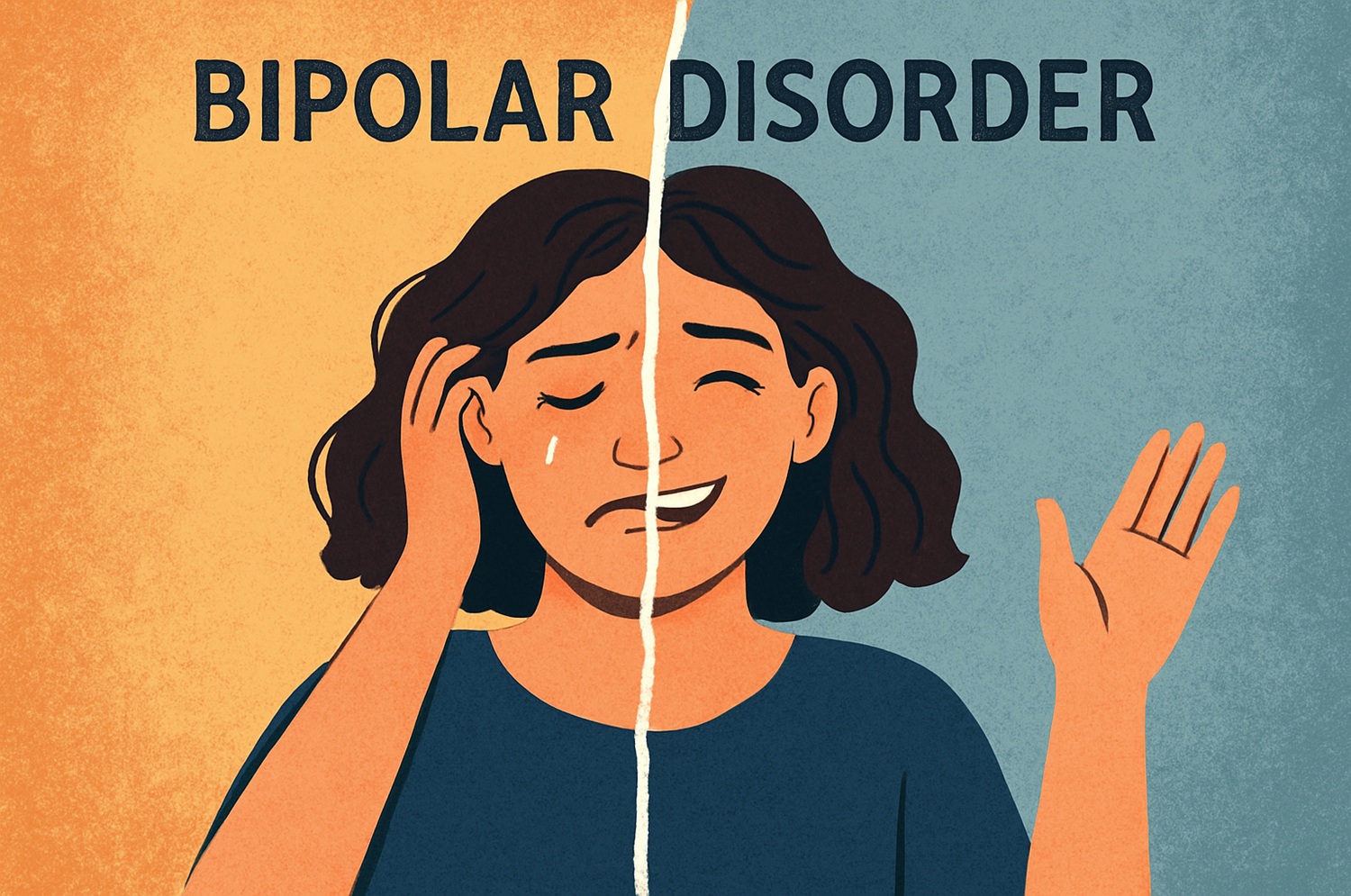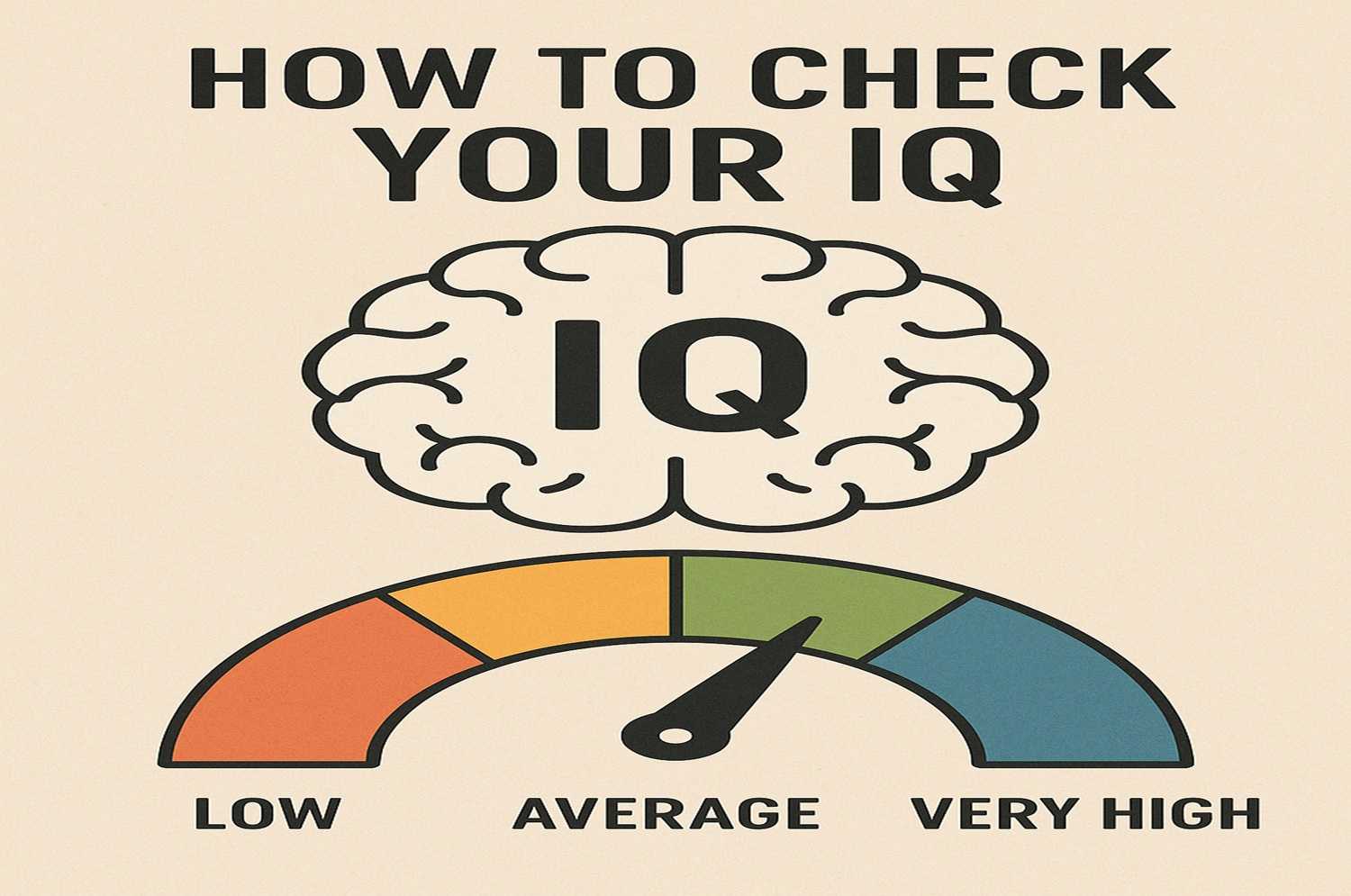What is Bipolar Disorder and Why Is It Often Misunderstood?
Start with a relatable question like: “Have you ever noticed extreme mood swings in someone close to you?” Then explain briefly what bipolar disorder is, why awareness is important, and what the guide will cover.
Table of Contents
ToggleWhat is Bipolar Disorder?
Bipolar disorder is a mental health condition that causes unusual shifts in mood, energy, and activity levels. These shifts go beyond ordinary ups and downs and can significantly affect a person’s daily life. People with bipolar disorder may experience intense emotional highs, known as mania or hypomania, and extreme lows, called depression.
Unlike common mood changes, bipolar episodes can last for days, weeks, or even months. During a manic phase, someone may feel unusually energetic, overly confident, or restless, while during a depressive phase, they may feel deeply sad, hopeless, or lose interest in activities they once enjoyed. Bipolar disorder is a medical condition, not a personality flaw, and with the right treatment, people can manage their symptoms and live fulfilling lives.
Difference Between Mood Swings and Bipolar Disorder
It’s natural for everyone to experience mood swings — for example, feeling happy in the morning but stressed by evening. These mood shifts are usually mild, short-lived, and linked to everyday situations like work pressure, arguments, or lack of sleep.
Bipolar disorder, however, is different. The mood changes are more intense, last much longer, and are not always connected to a specific event. For instance:
- Mood swings: Temporary emotional shifts that come and go quickly.
- Bipolar disorder: Prolonged episodes of mania or depression that may disrupt relationships, work, and overall health.
In simple terms, mood swings are like weather changes, while bipolar disorder is more like a change in climate — deeper, lasting, and requiring medical attention.
Types of Bipolar Disorder
Bipolar I Disorder
Bipolar I Disorder is the most severe form of the condition. It is characterized by at least one manic episode that lasts for a week or longer, often intense enough to require hospitalization. These episodes may include extreme energy, risky behavior, racing thoughts, and little need for sleep. While depressive episodes are also common, they are not required for a diagnosis. Because of its intensity, Bipolar I can significantly affect daily life, relationships, and work if left untreated.
Bipolar II Disorder
Unlike Bipolar I, Bipolar II Disorder involves a pattern of hypomanic episodes and major depressive episodes. Hypomania is less intense than full mania—it may boost productivity and energy but usually doesn’t cause severe impairment or hospitalization. However, the depressive episodes in Bipolar II can be very disabling and often last longer. People with Bipolar II often struggle more with depression than mania, making it a condition that is frequently misdiagnosed as major depression.
Cyclothymic Disorder
Cyclothymic Disorder, also known as Cyclothymia, is a milder but chronic form of bipolar disorder. It involves periods of hypomanic symptoms and mild depressive symptoms that last for at least two years in adults (one year in children and adolescents). While the symptoms are less severe than in Bipolar I or II, they are persistent and can interfere with emotional stability and daily functioning. Cyclothymia often goes unnoticed or untreated because symptoms may appear subtle compared to other forms.
Other Specified & Unspecified Types
In some cases, individuals experience bipolar-like symptoms that do not fit neatly into the categories above. These are classified as Other Specified Bipolar and Related Disorders or Unspecified Bipolar Disorders. For example, a person may have short-lasting hypomanic episodes or mood shifts linked to medical conditions or substance use. These categories ensure that individuals who show significant symptoms but do not meet strict diagnostic criteria can still receive proper treatment and support.
Symptoms of Bipolar Disorder
Bipolar disorder is marked by extreme mood swings that shift between mania (high energy) and depression (low energy). Recognizing these symptoms early is essential for timely treatment and better quality of life. Below are the key patterns you should know:
Manic Episode Symptoms
During a manic phase, a person may feel overly energetic, restless, and unusually confident. While these bursts of energy may appear positive at first, they can quickly spiral into risky or destructive behavior. Common manic symptoms include:
- Elevated or unusually irritable mood
- Racing thoughts and rapid speech
- Decreased need for sleep without feeling tired
- Impulsive decisions such as reckless spending or risky sexual behavior
- Inflated self-esteem or grandiosity
- Difficulty concentrating or staying on one task
Depressive Episode Symptoms
In contrast, depressive episodes can bring overwhelming sadness and fatigue that interfere with everyday life. These periods are often longer and can be disabling if untreated. Symptoms may include:
- Persistent feelings of sadness, hopelessness, or emptiness
- Loss of interest in hobbies or activities once enjoyed
- Low energy, excessive fatigue, or oversleeping
- Difficulty making decisions or concentrating
- Changes in appetite and weight
- Thoughts of death, self-harm, or suicide (in severe cases)
Mixed Episodes
A mixed episode occurs when symptoms of mania and depression appear simultaneously or in rapid succession. This can be especially confusing and dangerous, as the person may feel both hopeless and highly energised at the same time. Signs of mixed episodes include:
- Intense irritability or agitation
- Racing thoughts combined with deep sadness
- High energy but no motivation or joy
- Insomnia with emotional distress
- Increased risk of suicidal thoughts due to conflicting emotions
Causes & Risk Factors
Understanding the root causes of mental health conditions is never simple—there is no single factor responsible. Instead, it usually develops from a mix of genetic influences, brain chemistry, and environmental triggers. Recognizing these risk factors can help in early intervention and effective management.
Genetic Factors
Research shows that mental health conditions often run in families, suggesting a strong genetic link. If a close relative, such as a parent or sibling, has struggled with the disorder, the likelihood of developing it yourself may be higher. However, genetics alone do not guarantee onset—it simply means the risk is greater.
Brain Chemistry & Neurological Impact
Our brain relies on neurotransmitters like serotonin, dopamine, and norepinephrine to regulate mood, thoughts, and behavior. When these chemicals become imbalanced, it can disrupt emotional stability and cognitive functioning. Structural differences in certain brain regions, identified through imaging studies, also suggest that neurological patterns play a key role in vulnerability.
Environmental & Lifestyle Triggers
Even with a genetic predisposition, environmental influences often act as the tipping point. Stressful life events, trauma, substance abuse, poor sleep, or chronic health conditions can trigger or worsen symptoms. Lifestyle habits—such as excessive alcohol use, lack of physical activity, and unhealthy coping mechanisms—may further increase susceptibility.
How to Diagnose Bipolar Disorder
When to Seek Medical Help
Bipolar disorder often goes unnoticed in its early stages because mood swings can be mistaken for stress, personality traits, or even lifestyle habits. However, if you or someone you love experiences intense mood shifts—from extreme highs (mania or hypomania) to deep lows (depression)—it’s important to take these signs seriously.
Seek medical help if you notice:
- Persistent mood changes that affect work, studies, or relationships.
- Episodes of over-activity, decreased need for sleep, or risky behavior.
- Periods of hopelessness, fatigue, or withdrawal lasting weeks.
- Suicidal thoughts or self-harming tendencies.
Early consultation with a mental health professional—such as a psychiatrist or clinical psychologist—can make a significant difference. The sooner the condition is identified, the sooner an effective treatment plan can begin.
Diagnostic Tests & Psychological Evaluations
Diagnosing bipolar disorder is not as simple as a blood test or an X-ray. Instead, it involves a comprehensive evaluation of mental health history, behavior patterns, and emotional experiences.
A typical diagnostic process may include:
- Clinical Interview – The psychiatrist asks detailed questions about mood changes, sleep habits, energy levels, thought patterns, and family history of mental illness.
- Psychological Questionnaires – Standardized tools, such as the Mood Disorder Questionnaire (MDQ), help screen for bipolar symptoms.
- Medical Tests – Although no lab test confirms bipolar disorder, doctors may run blood tests or physical exams to rule out conditions like thyroid issues or substance effects that mimic mood symptoms.
- Observation Over Time – Because bipolar disorder is episodic, diagnosis often requires monitoring symptoms over weeks or months to identify patterns of mania and depression.
- Collateral Information – Sometimes input from family members or close friends helps provide a clearer picture of mood shifts that the patient might overlook.
A correct diagnosis is essential because bipolar disorder can easily be confused with depression, ADHD, or personality disorders. That’s why self-diagnosis is never recommended—professional assessment ensures proper treatment and long-term management.
Treatment & Management Options
Managing bipolar disorder requires a comprehensive treatment plan that balances medical care, therapy, and lifestyle support. The goal is not only to stabilize mood swings but also to help individuals live healthier, more fulfilling lives. Below are the key approaches commonly used:
Medications (Mood Stabilizers, Antidepressants, Antipsychotics)
Medication is often the first line of treatment for bipolar disorder. Mood stabilizers such as lithium or valproate help control extreme highs and lows. In cases where depressive episodes are more severe, antidepressants may be prescribed carefully under medical supervision. Antipsychotics are also used when symptoms include hallucinations, delusions, or severe mania. Since each person’s response can differ, doctors usually adjust medications to find the most effective balance with minimal side effects.
Psychotherapy & Counseling
Alongside medication, psychotherapy plays a vital role in managing bipolar disorder. Cognitive Behavioral Therapy (CBT) helps patients identify and change negative thought patterns, while Interpersonal Therapy (IPT) focuses on improving relationships and daily routines. Counseling also provides a safe space to process emotions, reduce stress, and build healthier coping skills. Working with a therapist regularly ensures long-term stability and relapse prevention.
Lifestyle Changes (Sleep, Exercise, Diet)
Healthy lifestyle habits are equally important in maintaining stability. Regular sleep patterns can reduce the risk of manic or depressive episodes. Exercise releases endorphins, improves mood, and reduces stress, making it a natural support for mental health. A balanced diet rich in whole foods, omega-3 fatty acids, and low in processed sugar helps regulate brain function. Even small daily changes can have a big impact on emotional well-being.
Support Systems & Coping Strategies
Living with bipolar disorder can feel overwhelming, which is why support systems are crucial. Family, friends, and support groups provide encouragement, understanding, and accountability. Learning coping strategies—such as mindfulness, journaling, stress management techniques, and relaxation practices—empowers individuals to handle challenges without triggering extreme mood shifts. Staying connected with supportive people can make the recovery journey smoother and less isolating.
How to Support Someone with Bipolar Disorder
Living with bipolar disorder can be overwhelming, not only for the person experiencing it but also for their loved ones. The right kind of support can make a world of difference in managing mood swings, maintaining stability, and improving quality of life. Here’s a practical guide on how to support someone with bipolar disorder.
Do’s & Don’ts
Do’s
- Listen without judgment: Offer a safe space for them to share their feelings without criticism.
- Encourage professional help: Support them in attending therapy sessions, psychiatric appointments, or sticking to medication routines.
- Educate yourself: Learn about bipolar disorder, its symptoms, and treatment options so you can provide informed support.
- Promote a healthy lifestyle: Encourage sleep routines, balanced meals, and gentle physical activity.
- Celebrate progress: Acknowledge small victories—whether it’s attending therapy or practicing self-care.
Don’ts
- Don’t dismiss their feelings: Avoid saying things like “Just snap out of it” or “Everyone feels this way.”
- Don’t push too hard: Over-involvement or excessive monitoring may feel suffocating. Respect their independence.
- Don’t stigmatize or label: Avoid negative terms that can worsen feelings of guilt or shame.
- Don’t ignore warning signs: If you notice sudden mood shifts or risky behavior, take them seriously.
Role of Family & Friends
Family and friends are the backbone of emotional stability for someone living with bipolar disorder. Here’s how they can play a supportive role:
- Be patient during mood swings: Understand that irritability or withdrawal is part of the illness, not a personal attack.
- Set healthy boundaries: Support does not mean neglecting your own needs. Balance is essential.
- Stay consistent: Consistency in communication and presence provides reassurance during uncertain times.
- Encourage open dialogue: Allow honest conversations about what helps and what doesn’t during manic or depressive phases.
- Be part of treatment plans: Sometimes attending therapy sessions with them helps you understand the journey better.
Crisis Management
Despite best efforts, crises such as severe depression, mania, or suicidal thoughts can occur. Here’s what to do:
- Recognize warning signs: Rapid speech, risky decisions, isolation, or hopelessness may signal an impending crisis.
- Have a plan ready: Keep emergency contacts, psychiatrists’ numbers, and crisis helplines easily accessible.
- Stay calm and reassuring: Panic can escalate the situation. Use a calm voice and grounded body language.
- Remove immediate dangers: If there’s a risk of self-harm, discreetly secure harmful objects.
- Seek professional help immediately: Call a doctor, therapist, or emergency services if the situation becomes unsafe.
Living Well with Bipolar Disorder
Success Stories & Inspiring Examples
Living with bipolar disorder can be challenging, but countless people have turned their struggles into powerful stories of hope. Celebrities, entrepreneurs, and everyday individuals have openly shared how they manage the condition while leading fulfilling lives. For example, many professionals have pursued successful careers by embracing treatment, building strong support networks, and practicing self-awareness. These stories remind us that a diagnosis doesn’t define someone’s future—it can be the beginning of a new journey of resilience and strength.
Daily Self-Care Routines
Consistency plays a key role in managing bipolar disorder. Simple, structured routines often make a huge difference in mood stability. A few examples include:
- Sleep hygiene: Going to bed and waking up at the same time daily.
- Balanced nutrition: Eating regular, healthy meals to avoid mood fluctuations.
- Exercise: Gentle activities like yoga, walking, or cycling to reduce stress.
- Mindfulness practices: Meditation, journaling, or breathing exercises for grounding.
- Medication adherence: Following prescribed treatments without skipping doses.
These small but powerful habits create stability and make daily life more manageable.
Building Resilience
Resilience is not about avoiding challenges—it’s about facing them with strength and flexibility. People with bipolar disorder often develop resilience by:
- Understanding their triggers and creating coping strategies.
- Leaning on trusted support systems like friends, family, or peer groups.
- Seeking professional guidance through therapy and psychiatry.
- Reframing setbacks as opportunities for growth rather than failures.
With time, resilience becomes a skill that helps individuals not just survive, but thrive, even when life feels unpredictable.
Read Also:
How to Build a Relationship Based on Interdependence: A Beginner’s Guide to Healthy Love
How to Meditate: Discover Powerful Meditate Benefits & Proven Meditation Benifits for Mind and Body
“गणपति सजावट की स्टेप-बाय-स्टेप गाइड: थीम, फूल और लाइटिंग के बेस्ट आइडिया”
FAQs
What is the main cause of bipolar disorder?
Bipolar disorder’s main cause is complex, involving genetic, brain chemistry, and environmental stress factors combined.
2. Can bipolar disorder be cured permanently?
Bipolar disorder cannot be permanently cured, but effective treatment helps manage symptoms and maintain stability.
3. What are the early warning signs of bipolar disorder?
Early signs include mood swings, sleep changes, irritability, high energy bursts, and difficulty concentrating consistently.
4. Is bipolar disorder genetic or environmental?
Bipolar disorder is influenced by both genetics and environment, often triggered by stress or trauma.
5. How do you calm down someone with bipolar disorder?
Stay calm, listen patiently, avoid arguments, offer reassurance, encourage professional help, and ensure a safe environment.









